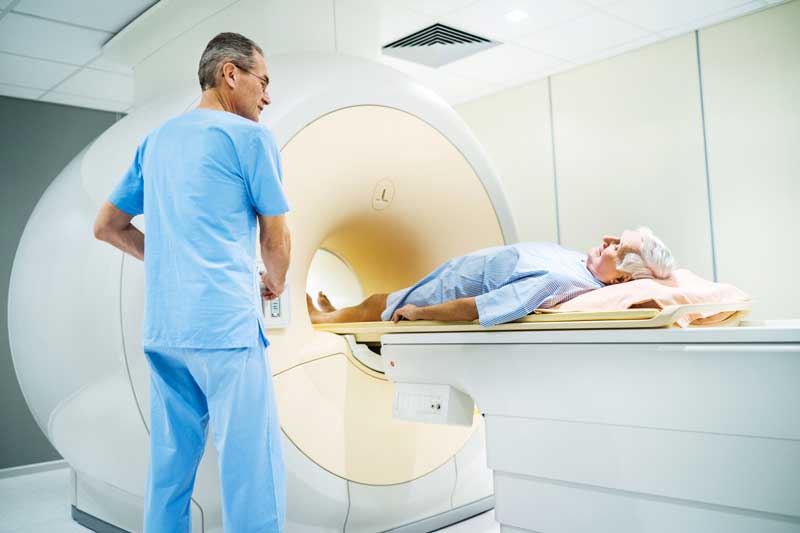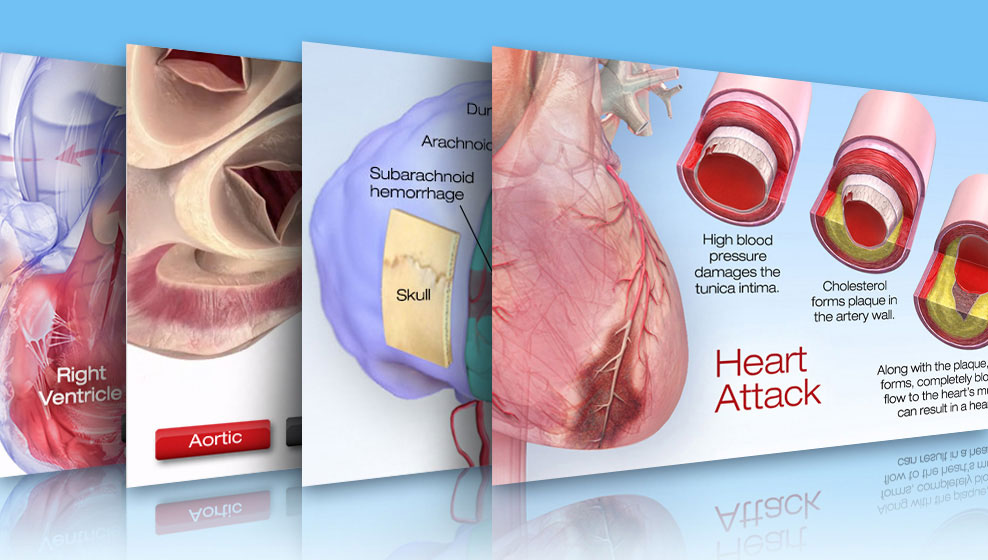Magnetic Resonance Imaging (MRI)
What is MRI?
Magnetic resonance imaging (MRI) is a noninvasive test that uses a magnetic field and radiofrequency waves to create detailed pictures of organs and structures inside your body. It can be used to examine your heart and blood vessels, and to identify areas of the brain affected by stroke. Magnetic resonance imaging is also sometimes called nuclear magnetic resonance (NMR) imaging.
Quick facts
- MRI uses a powerful magnetic field, radiofrequency waves, and a computer to create detailed cross-sectional (2-dimensional) and 3-dimensional images of the inside of your body without using ionizing radiation (like X-rays, computed tomography, or nuclear imaging).
- The test can show your heart’s structure (muscle, valves and chambers) and how well blood flows through your heart and major vessels.
- MRI of the heart lets your doctor see if your heart is damaged from a heart attack, or if there is lack of blood flow to the heart muscle because of narrowed or blocked arteries.
- MRI of the brain is used to diagnose stroke, aneurysm and other brain abnormalities.
- MRI of the pelvis and legs helps to diagnose peripheral artery disease (PAD).
Why do people have MRI scans for heart problems?
An MRI can help your doctor diagnose many different heart conditions, including:
- Tissue damage from a heart attack
- Reduced blood flow in the heart muscle to help determine whether heart artery blockages are the cause of your chest pain (angina)
- Problems in the aorta—the heart’s main artery—such as a tear, aneurysm (bulge), or narrowing
- Diseases of the pericardium (outer lining of the heart muscle) such as constrictive pericarditis
- Heart muscle diseases, such as heart failure or enlargement of the heart, and abnormal growths such as cancerous tumors
- Heart valve disorders, such as regurgitation
- Congenital heart problems and the success of surgical repair
MRI may be used instead of other tests that use ionizing radiation or iodine-containing contrast dyes, or both, such as X-ray, angiograms, computed tomography (CT) scans. Using MRI to look at blood vessels and how blood flows through them is called magnetic resonance angiography (MRA). Unlike a traditional X-ray angiogram, this procedure doesn’t require inserting a catheter into your arteries.
MRI techniques can also be used to measure heart function or how much blood the left ventricle can pump out to the body.
What are the risks of MRI?
MRI is a safe and painless test for most people. People with any type of metal device inside the body should not have an MRI unless the device is certified as MRI safe. Such devices include:
- Pacemakers and implantable cardioverter defibrillators (ICDs)
- Inner ear (cochlear) implants
- Neuro-muscular stimulators such as those used for pain management or muscle rehabilitation
- Implanted drug infusion pumps
- Intrauterine devices (IUDs)
- Brain aneurysm clips that are not approved for MRI
- Some dental implants (check with your dentist to make sure they are not magnetic)
- You should avoid MRI if you have metal fragments in your body. Metal fragments in the eyes can be especially dangerous because the magnet may move the metal, causing eye damage or blindness.
- For some MRIs, a special contrast dye (without iodine) may be used. This contrast dye is considered not safe for people with advanced kidney failure.
Check with your doctor about the safety of MRI if you:
- Have a stent or artificial heart valve, or if you have had open-heart surgery recently.
- Are pregnant, especially during the first 3 months.
- Have tattoos or permanent (tattooed) makeup. You might feel some mild discomfort or a burning feeling on your skin from the metal in the darker inks of the tattoo.
- Have been told you have kidney problems
How do I prepare for an MRI?
- Before your MRI scan, eat normally and take your usual medicines unless your doctor tells you not to.
- It’s very important to remove all objects that may contain metal or electronics (jewelry such as rings or earrings, hairpins, dentures, watches and hearing aids) before the test.
- Don’t bring your credit or debit cards into the MRI room. The machine might erase or damage the magnetic strip on the back of the cards.
- If you have any implants or clips in your body, have your doctor write a note to indicate if they are safe for MRI.
What happens during an MRI?
A radiologist or MRI technologist usually performs the scan in a hospital, clinic or imaging center using special equipment.
- You’ll lie down on a moveable table that slides into the MRI machine. The machine looks like a long metal tube.
- Depending on which part of your body needs to be checked, a small coil may be placed on that part of the body to send the radio waves and receive the MRI signal.
- Your technologist will watch you from another room. You can talk with him or her by microphone. In some cases, a friend or family member may stay in the room with you.
- The MRI machine will create a strong magnetic field around you, and radio waves will be directed at the area of your body to be imaged. You won’t feel the magnetic field or radio waves.
- During the MRI scan, the magnet produces loud tapping or thumping sounds and other noises. You may be given earplugs or you may listen to music with headphones to help block the noise.
- In some cases, you may have an intravenous (IV) line in your hand or arm for injecting a contrast agent into your veins (for an MRA). The contrast agent produces better images of your tissues and blood vessels. It does not contain iodine and is less likely to cause an allergic reaction compared to the agents used for computed tomography (CT) scans.
- An MRI scan lasts between 30 and 90 minutes.
You’ll need to lie still during the exam because movement can blur the images of your body. If you aren’t comfortable in close spaces, tell your doctor before the test. You can get a sedative to help you stay calm. Some clinics have machines with shorter magnets or wider openings to make you more comfortable.
What happens after my MRI?
- You can usually go back to your normal activities right away.
- If you had a sedative, you’ll stay at the MRI center until the effects of the sedative wear off. You’ll need someone to drive you home.
- The radiologist will examine the images and send your doctor a copy of the report. Make an appointment with your doctor to discuss the test results.
How can I learn more about an MRI?
Talk with your doctor. Here are some good questions to ask:
- Why do I need an MRI?
- Why are you doing this test rather than a different one?
- Will you use a contrast agent for my MRI? What agent will be used?
- Is my kidney function good enough for a contrast agent to be used?
- What if I’m claustrophobic?
- When will I get my test results?
- Will I need to have more tests after this?

